
Have you ever recommended a book to someone and given them a quick overview? Then you’ve created a summary before!
Summarizing is a common part of everyday communication. It feels easy when you’re recounting what happened on your favorite show, but what do you do when the information gets a little more complex?
Written summaries come with their own set of challenges. You might ask yourself:
- What details are unnecessary?
- How do you put this in your own words without changing the meaning?
- How close can you get to the original without plagiarizing it?
- How long should it be?
The answers to these questions depend on the type of summary you are doing and why you are doing it.
A summary in an academic setting is different to a professional summary—and both of those are very different to summarizing a funny story you want to tell your friends.
One thing they all have in common is that you need to relay information in the clearest way possible to help your reader understand. We’ll look at some different forms of summary, and give you some tips on each.
Let’s get started!
What Is a Summary?
A summary is a shorter version of a larger work. Summaries are used at some level in almost every writing task, from formal documents to personal messages.
When you write a summary, you have an audience that doesn’t know every single thing you know.
When you want them to understand your argument, topic, or stance, you may need to explain some things to catch them up.
Instead of having them read the article or hear every single detail of the story or event, you instead give them a brief overview of what they need to know.
How Do You Write a Summary?
Academic, professional, and personal summaries each require you to consider different things, but there are some key rules they all have in common.
Let’s go over a few general guides to writing a summary first.
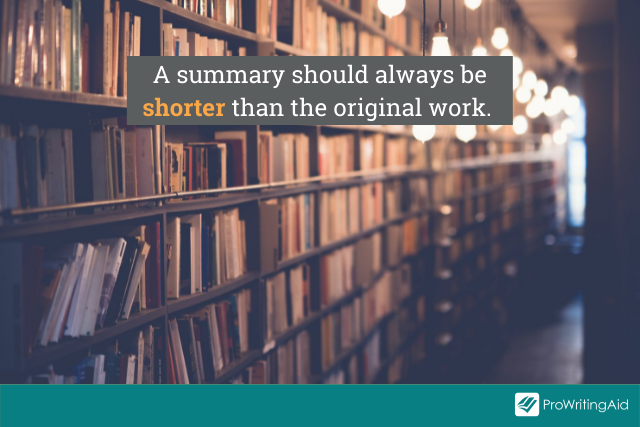
1. A summary should always be shorter than the original work, usually considerably.
Even if your summary is the length of a full paper, you are likely summarizing a book or other significantly longer work.
2. A summary should tell the reader the highlights of what they need to know without giving them unnecessary details.
3. It should also include enough details to give a clear and honest picture.
For example, if you summarize an article that says “The Office is the greatest television show of all time,” but don’t mention that they are specifically referring to sitcoms, then you changed the meaning of the article. That’s a problem! Similarly, if you write a summary of your job history and say you volunteered at a hospital for the last three years, but you don’t add that you only went twice in that time, it becomes a little dishonest.
4. Summaries shouldn’t contain personal opinion.
While in the longer work you are creating you might use opinion, within the summary itself, you should avoid all personal opinion. A summary is different than a review. In this moment, you aren’t saying what you think of the work you are summarizing, you are just giving your audience enough information to know what the work says or did.
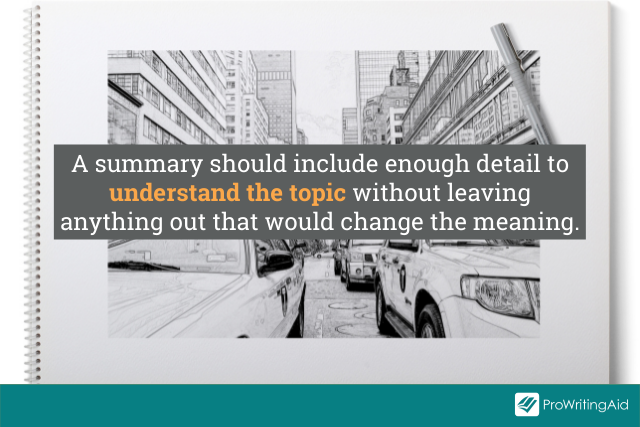
Now that we have a good idea of what summaries are in general, let’s talk about some specific types of summary you will likely have to do at some point in your writing life.
How Do You Write an Academic Summary?
An academic summary is one you will create for a class or in other academic writing. The exact elements you will need to include depend on the assignment itself.
However, when you’re asked for an academic summary, this usually this means one of five things, all of which are pretty similar:
- You need to do a presentation in which you talk about an article, book, or report.
- You write a summary paper in which the entire paper is a summary of a specific work.
- You summarize a class discussion, lesson, or reading in the form of personal notes or a discussion board post.
- You do something like an annotated bibliography where you write short summaries of multiple works in preparation of a longer assignment.
- You write quick summaries within the body of another assignment. For example, in an argumentative essay, you will likely need to have short summaries of the sources you use to explain their argument before getting into how the source helps you prove your point.
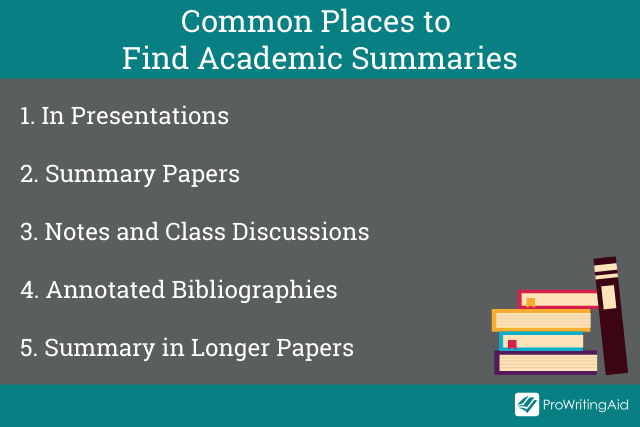
Regardless of what type of summary you are doing, though, there are a few steps you should always follow:
- Skim the work you are summarizing before you read it. Notice what stands out to you.
- Next, read it in depth. Do the same things stand out?
- Put the full text away and write in a few sentences what the main idea or point was.
- Go back and compare to make sure you didn’t forget anything.
- Expand on this to write and then edit your summary.
What Are the Four Types of Academic Summaries?
Each type of academic summary requires slightly different things. Let’s get down to details.
How Do I Write a Summary Paper?
Sometimes teachers assign something called a summary paper. In this, the entire thing is a summary of one article, book, story, or report.
To understand how to write this paper, let’s talk a little bit about the purpose of such an assignment.
A summary paper is usually given to help a teacher see how well a student understands a reading assignment, but also to help the student digest the reading. Sometimes, it can be difficult to understand things we read right away.
However, a good way to process the information is to put it in our own words. That is the point of a summary paper.
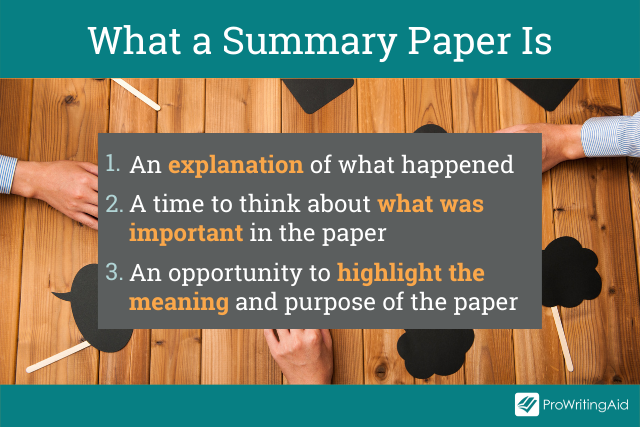
A summary paper is:
- A way to explain in our own words what happened in a paper, book, etc.
- A time to think about what was important in the paper, etc.
- A time to think about the meaning and purpose behind the paper, etc.
Here are some things that a summary paper is not:
- A review. Your thoughts and opinions on the thing you are summarizing don’t need to be here unless otherwise specified.
- A comparison. A comparison paper has a lot of summary in it, but it is different than a summary paper. In this, you are just saying what happened, but you aren’t saying places it could have been done differently.
- A paraphrase (though you might have a little paraphrasing in there). In the section on using summary in longer papers, I talk more about the difference between summaries, paraphrases, and quotes.
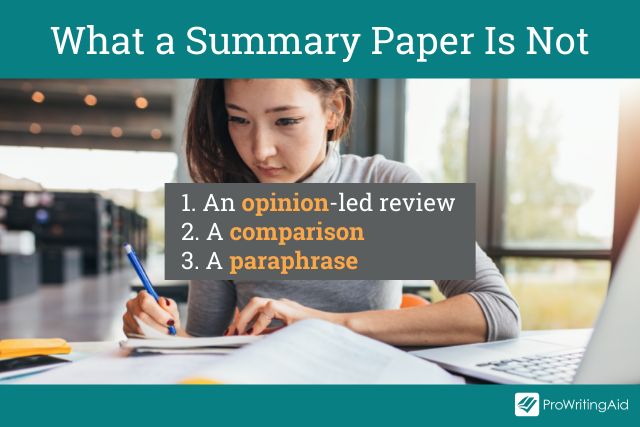
Because a summary paper is usually longer than other forms of summary, you will be able to chose more detail. However, it still needs to focus on the important events. Summary papers are usually shorter papers.
Let’s say you are writing a 3–4 page summary. You are likely summarizing a full book or an article or short story, which will be much longer than 3–4 pages.
Imagine that you are the author of the work, and your editor comes to you and says they love what you wrote, but they need it to be 3–4 pages instead.
How would you tell that story (argument, idea, etc.) in that length without losing the heart or intent behind it? That is what belongs in a summary paper.
How Do I Write Useful Academic Notes?
Sometimes, you need to write a summary for yourself in the form of notes or for your classmates in the form of a discussion post.
You might not think you need a specific approach for this. After all, only you are going to see it.
However, summarizing for yourself can sometimes be the most difficult type of summary. If you try to write down everything your teacher says, your hand will cramp and you’ll likely miss a lot.
Yet, transcribing doesn’t work because studies show that writing things down (not typing them) actually helps you remember them better.
So how do you find the balance between summarizing the lessons without leaving out important points?
There are some tips for this:
- If your professor writes it on the board, it is probably important.
- What points do your textbooks include when summarizing information? Use these as a guide.
- Write the highlight of every X amount of time, with X being the time you can go without missing anything or getting tired. This could be one point per minute, or three per five minutes, etc.
How Do I Create an Annotated Biography?
An annotated bibliography requires a very specific style of writing. Often, you will write these before a longer research paper. They will ask you to find a certain amount of articles and write a short annotation for each of them.
While an annotation is more than just a summary, it usually starts with a summary of the work. This will be about 2–3 sentences long. Because you don’t have a lot of room, you really have to think about what the most important thing the work says is.
This will basically ask you to explain the point of the article in these couple of sentences, so you should focus on the main point when expressing it.
Here is an example of a summary section within an annotation about this post:
“In this post, the author explains how to write a summary in different types of settings. She walks through academic, professional, and personal summaries.
Ultimately, she claims that summaries should be short explanations that get the audience caught up on the topic without leaving out details that would change the meaning.”

Can I Write a Summary Within an Essay?
Perhaps the most common type of summary you will ever do is a short summary within a longer paper.
For example, if you have to write an argumentative essay, you will likely need to use sources to help support your argument.
However, there is a good chance that your readers won’t have read those same sources.
So, you need to give them enough detail to understand your topic without spending too much time explaining and not enough making your argument.
While this depends on exactly how you are using summary in your paper, often, a good amount of summary is the same amount you would put in an annotation.
Just a few sentences will allow the reader to get an idea of the work before moving on to specific parts of it that might help your argument.
What’s the Difference Between Summarizing, Paraphrasing, and Using Quotes?
One important thing to recognize when using summaries in academic settings is that summaries are different than paraphrases or quotes.
A summary is broader and more general. A paraphrase, on the other hand, puts specific parts into your own words. A quote uses the exact words of the original. All of them, however, need to be cited.
Let’s look at an example:
Take these words by Thomas J. Watson:
”Would you like me to give you a formula for success? It’s quite simple, really. Double your rate of failure. You are thinking of failure as the enemy of success. But it isn’t as all. You can be discouraged by failure—or you can learn from it. So go ahead and make mistakes. Make all you can. Because, remember, that’s where you will find success.”
Let’s say I was told to write a summary, a paraphrase, and a quote about this statement. This is what it might look like:
Summary: Thomas J. Watson said that the key to success is actually to fail more often. (This is broad and doesn’t go into details about what he says, but it still gives him credit.)
Paraphrase: Thomas J. Watson, on asking if people would like his formula for success, said that the secret was to fail twice as much. He claimed that when you decide to learn from your mistakes instead of being disappointed by them, and when you start making a lot of them, you will actually find more success. (This includes most of the details, but it is in my own words, while still crediting the source.)
Quote: Thomas J. Watson said, ”Would you like me to give you a formula for success? It’s quite simple, really. Double your rate of failure. You are thinking of failure as the enemy of success. But it isn’t at all. You can be discouraged by failure—or you can learn from it. So go ahead and make mistakes. Make all you can. Because, remember, that’s where you will find success.” (This is the exact words of the original with quotation marks and credit given.)
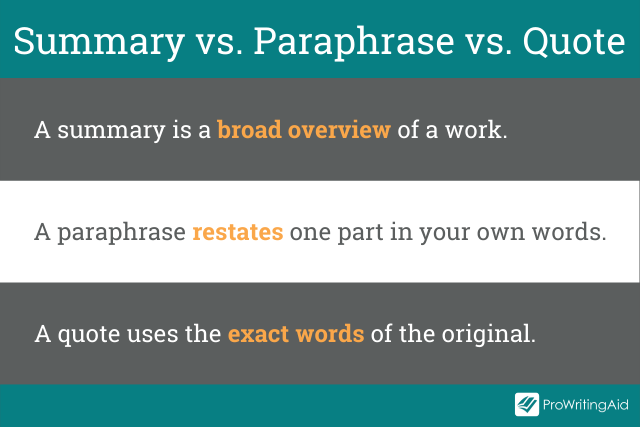
Avoiding Plagiarism
One of the hardest parts about summarizing someone else’s writing is avoiding plagiarism.

That’s why I have a few rules/tips for you when summarizing anything:
1. Always cite.
If you are talking about someone else’s work in any means, cite your source. If you are summarizing the entire work, all you probably need to do (depending on style guidelines) is say the author’s name. However, if you are summarizing a specific chapter or section, you should state that specifically. Finally, you should make sure to include it in your Work Cited or Reference page.
2. Change the wording.
Sometimes when people are summarizing or paraphrasing a work, they get too close to the original, and actually use the exact words. Unless you use quotation marks, this is plagiarism. However, a good way to avoid this is to hide the article while you are summarizing it. If you don’t have it in front of you, you are less likely to accidentally use the exact words. (However, after you are done, double check that you didn’t miss anything important or give wrong details.)
3. Use a plagiarism checker.
Of course, when you are writing any summary, especially academic summaries, it can be easy to cross the line into plagiarism. If this is a place where you struggle, then ProWritingAid can help.
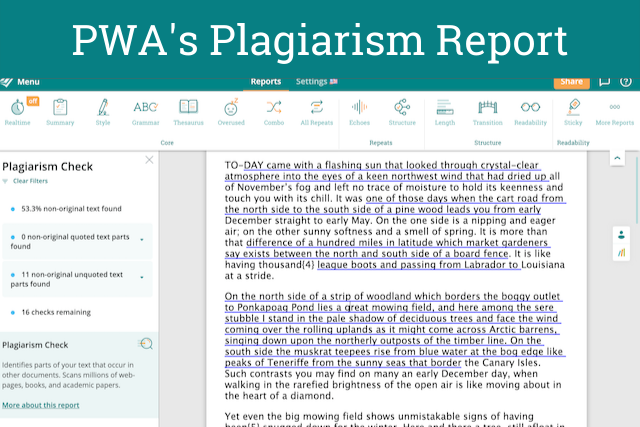
Just use our Plagiarism Report. It’ll highlight any unoriginal text in your document so you can make sure you are citing everything correctly and summarizing in your own words.
Find out more about ProWritingAid plagiarism bundles.
How Do I Write a Professional Summary?
Along with academic summaries, you might sometimes need to write professional summaries. Often, this means writing a summary about yourself that shows why you are qualified for a position or organization.
In this section, let’s talk about two types of professional summaries: a LinkedIn summary and a summary section within a resume.
How Do I Write My LinkedIn Bio?
LinkedIn is all about professional networking. It offers you a chance to share a brief glimpse of your professional qualifications in a paragraph or two.
This can then be sent to professional connections, or even found by them without you having to reach out. This can help you get a job or build your network.
Your summary is one of the first things a future employer might see about you, and how you write yours can make you stand out from the competition.

Here are some tips on writing a LinkedIn summary:
- Before you write it, think about what you want it to do. If you are looking for a job, what kind of job? What have you done in your past that would stand out to someone hiring for that position? That is what you will want to focus on in your summary.
- Be professional. Unlike many social media platforms, LinkedIn has a reputation for being more formal. Your summary should reflect that to some extent.
- Use keywords. Your summary is searchable, so using keywords that a recruiter might be searching for can help them find you.
- Focus on the start. LinkedIn shows the first 300 characters automatically, and then offers the viewer a chance to read more. Make that start so good that everyone wants to keep reading.
- Focus on accomplishments. Think of your life like a series of albums, and this is your speciality “Greatest Hits” album. What “songs” are you putting on it?

How Do I Summarize My Experience on a Resume?
Writing a professional summary for a resume is different than any other type of summary that you may have to do.
Recruiters go through a lot of resumes every day. They don’t have time to spend ages reading yours, which means you have to wow them quickly.
To do that, you might include a section at the top of your resume that acts almost as an elevator pitch: That one thing you might say to a recruiter to get them to want to talk to you if you only had a 30-second elevator ride.
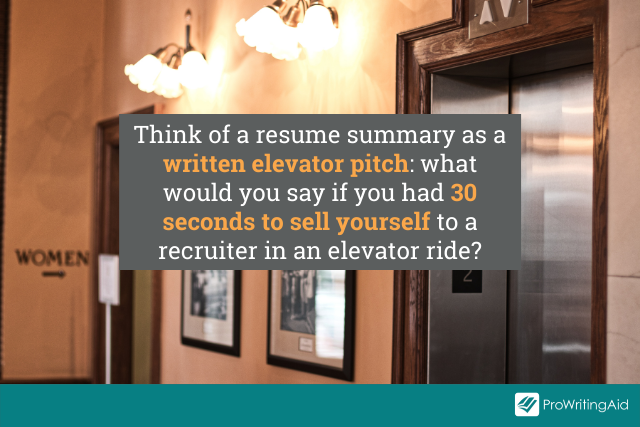
If you don’t have a lot of experience, though, you might want to skip this section entirely and focus on playing up the experience you do have.
Writing or Telling a Summary in Personal Situations
Outside of academic and personal summaries, you use summary a lot in your day-to-day life.
Whether it is telling a good piece of trivia you just learned or a funny story that happened to you, or even setting the stage in creative writing, you summarize all the time.
How you use summary can be an important consideration in whether people want to read your work (or listen to you talk).
Here are some things to think about when telling a story:
- Pick interesting details. Too many and your point will be lost. Not enough, and you didn’t paint the scene or give them a complete idea about what happened.
- Play into the emotions. When telling a story, you want more information than the bare minimum. You want your reader to get the emotion of the story. That requires a little bit more work to accomplish.
- Focus. A summary of one story can lead to another can lead to another. Think about storytellers that you know that go off on a tangent. They never seem to finish one story without telling 100 others!

Summarizing Summaries
To wrap up (and to demonstrate everything I just talked about), let’s summarize this post into its most essential parts:
A summary is a great way to quickly give your audience the information they need to understand the topic you are discussing without having to know every detail.
How you write a summary is different depending on what type of summary you are doing:
- An academic summary usually gets to the heart of an article, book, or journal, and it should highlight the main points in your own words. How long it should be depends on the type of assignment it is.
- A professional summary highlights you and your professional, academic, and volunteer history. It shows people in your professional network who you are and why they should hire you, work with you, use your talents, etc.
Being able to tell a good story is another form of summary. You want to tell engaging anecdotes and facts without boring your listeners. This is a skill that is developed over time.



